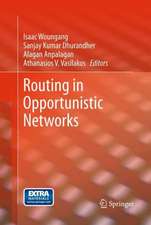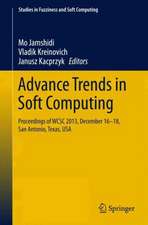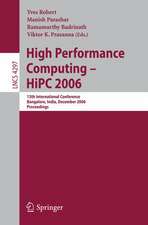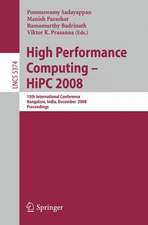Autonomic Communication
Editat de Athanasios V. Vasilakos, Manish Parashar, Stamatis Karnouskos, Witold Pedryczen Limba Engleză Hardback – 4 oct 2009
This edited volume explores the challenges of technologies to realize the vision where devices and applications seamlessly interconnect, intelligently cooperate, and autonomously manage themselves, and as a result, the borders of virtual and real world vanish or become significantly blurred.
| Toate formatele și edițiile | Preț | Express |
|---|---|---|
| Paperback (1) | 991.79 lei 6-8 săpt. | |
| Springer Us – 4 sep 2014 | 991.79 lei 6-8 săpt. | |
| Hardback (1) | 998.21 lei 6-8 săpt. | |
| Springer Us – 4 oct 2009 | 998.21 lei 6-8 săpt. |
Preț: 998.21 lei
Preț vechi: 1247.77 lei
-20% Nou
Puncte Express: 1497
Preț estimativ în valută:
191.03€ • 198.70$ • 157.71£
191.03€ • 198.70$ • 157.71£
Carte tipărită la comandă
Livrare economică 15-29 aprilie
Preluare comenzi: 021 569.72.76
Specificații
ISBN-13: 9780387097527
ISBN-10: 038709752X
Pagini: 374
Ilustrații: XVIII, 374 p.
Dimensiuni: 155 x 235 x 22 mm
Greutate: 0.73 kg
Ediția:2010
Editura: Springer Us
Colecția Springer
Locul publicării:New York, NY, United States
ISBN-10: 038709752X
Pagini: 374
Ilustrații: XVIII, 374 p.
Dimensiuni: 155 x 235 x 22 mm
Greutate: 0.73 kg
Ediția:2010
Editura: Springer Us
Colecția Springer
Locul publicării:New York, NY, United States
Public țintă
ResearchDescriere
New paradigms for communication/networking systems are needed in order to tackle such emerging issues as heterogeneity, complexity and management of evolvable infrastructures, thus requiring approaches that are both task- and knowledge-driven. The networking and seamless integration of concepts, technologies and devices in a dynamically changing environment poses many challenges to the research community, including interoperability, programmability, management, openness, reliability, performance, context awareness, intelligence, autonomy, security, privacy, safety, and semantics. Inspired by biological systems, autonomic communication envisions communication systems that can organize, configure, optimize, protect, and heal themselves with minimal involvement of human administrators.
Autonomic Communication explores conceptual models and associated technologies that will uphold the vision of autonomic communication where devices and applications blur the boundaries between virtual and real worlds as they seamlessly interconnect, intelligently cooperate, and autonomously manage themselves.
Written by leading international researchers, the contributions give testimony to the challenges and prospects of this rapidly growing area. The volume is composed of chapters covering a wide range of issues related to autonomic communication.
Part I Autonomic Communication Infrastructure
Autonomic Communication explores conceptual models and associated technologies that will uphold the vision of autonomic communication where devices and applications blur the boundaries between virtual and real worlds as they seamlessly interconnect, intelligently cooperate, and autonomously manage themselves.
Written by leading international researchers, the contributions give testimony to the challenges and prospects of this rapidly growing area. The volume is composed of chapters covering a wide range of issues related to autonomic communication.
Part I Autonomic Communication Infrastructure
- Social-based autonomic routing in opportunistic networks
- A Collaborative Knowledge Plane for Autonomic Networks
- A Rate Feedback Predictive Control Scheme Based on Neural Network and Control Theory for Autonomic Communication
- Hovering Information – Self-Organizing Information that Finds its Own Storage
- The CASCADAS Framework for Autonomic Communications
- Autonomic Middleware for Automotive Embedded Systems
- Social Opportunistic Computing: Design for Autonomic User-Centric Systems
- Programming and Validation Techniques for Reliable Goal-driven Autonomic Software
- Autonomic Communication in Pervasive Multimodal Multimedia Computing System
- Self-healing for Autonomic Pervasive Computing
- Map-based Design for Autonomic Wireless Sensor Networks
- An Efficient, Scalable and Robust P2P Overlay for Autonomic Communication
- Autonomic and Coevolutionary Sensor Networking
Cuprins
Bio-inspired Autonomic Structures: a middleware for Telecommunications Ecosystems.- Social-based Autonomic Routing In Opportunistic Networks.- A Collaborative Knowledge Plane for Autonomic Networks.- A Rate Feedback Predictive Control Scheme Based on Neural Network and Control Theory for Autonomic Communication.- Hovering Information - Self Organizing Information That Finds Its Own Storage.- The CASCADAS Framework for Autonomic Communications.- Autonomic Middleware for Automotive Embedded Systems.- Social Opportunistic Computing: Design for Autonomic User-Centric Systems.- Programming and Validation Techniques for Reliable Goal-driven Autonomic Software.- Autonomic Communication in Pervasive Multimodal Multimedia Computing Systems.- Self-healing for Autonomic Pervasive Computing.- Map-based Design for Autonomic Wireless Sensor Networks.- An Efficient, Scalable and Robust P2P Overlay for Autonomic Communication.- Autonomic and Coevolutionary Sensor Networking.-
Textul de pe ultima copertă
New paradigms for communication/networking systems are needed in order to tackle such emerging issues as heterogeneity, complexity and management of evolvable infrastructures, thus requiring approaches that are both task- and knowledge-driven. The networking and seamless integration of concepts, technologies and devices in a dynamically changing environment poses many challenges to the research community, including interoperability, programmability, management, openness, reliability, performance, context awareness, intelligence, autonomy, security, privacy, safety, and semantics. Inspired by biological systems, autonomic communication envisions communication systems that can organize, configure, optimize, protect, and heal themselves with minimal involvement of human administrators.
Autonomic Communication explores conceptual models and associated technologies that will uphold the vision of autonomic communication where devices and applications blur the boundaries between virtual and real worlds as they seamlessly interconnect, intelligently cooperate, and autonomously manage themselves.
Written by leading international researchers, the contributions give testimony to the challenges and prospects of this rapidly growing area. The volume is composed of chapters covering a wide range of issues related to autonomic communication.
Part I Autonomic Communication Infrastructure
Autonomic Communication explores conceptual models and associated technologies that will uphold the vision of autonomic communication where devices and applications blur the boundaries between virtual and real worlds as they seamlessly interconnect, intelligently cooperate, and autonomously manage themselves.
Written by leading international researchers, the contributions give testimony to the challenges and prospects of this rapidly growing area. The volume is composed of chapters covering a wide range of issues related to autonomic communication.
Part I Autonomic Communication Infrastructure
- Social-based autonomic routing in opportunistic networks
- A Collaborative Knowledge Plane for Autonomic Networks
- A Rate Feedback Predictive Control Scheme Based on Neural Network and Control Theory for Autonomic Communication
- Hovering Information – Self-Organizing Information that Finds its Own Storage
- The CASCADAS Framework for Autonomic Communications
- Autonomic Middleware for Automotive Embedded Systems
- Social Opportunistic Computing: Design for Autonomic User-Centric Systems
- Programming and Validation Techniques for Reliable Goal-driven Autonomic Software
- Autonomic Communication in Pervasive Multimodal Multimedia Computing System
- Self-healing for Autonomic Pervasive Computing
- Map-based Design for Autonomic Wireless Sensor Networks
- An Efficient, Scalable and Robust P2P Overlay for Autonomic Communication
- Autonomic and Coevolutionary Sensor Networking
Caracteristici
Autonomic communication is an open long-term research initiative gaining global momentum
Provides a first systematic and comprehensive treatment of this new area
Explores both conceptual models and associated technologies
Includes supplementary material: sn.pub/extras
Provides a first systematic and comprehensive treatment of this new area
Explores both conceptual models and associated technologies
Includes supplementary material: sn.pub/extras
























